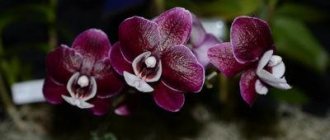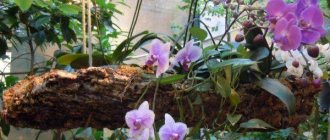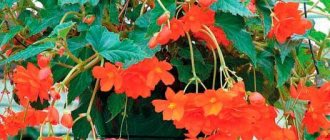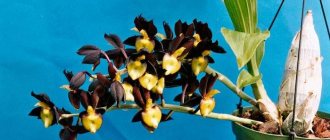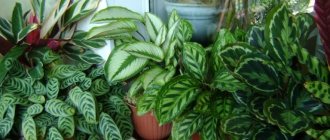Description
The popular name “butterfly” appealed to many phalaenopsis lovers. Fantasy suggests a similarity between the shape of the sepals (side petals) and the wings of a butterfly.
Big lip means “big lips” and indeed, the middle of the flower has an unusually large and unfolded lower petal.
The texture of the petals is delicate, tender, easily damaged, and does not tolerate transportation well.
Attention! A distinctive feature of this species is the complex, expanded shape of the lip. The standard phalaenopsis has a cupped lip. Big linden is distinguished by such expanded petals that the lower one becomes completely flat.
Color shades are not important for the classification of this group of phalaenopsis.
Prevention of various problems
- Choose the type with which you can create all the necessary conditions.
- Do not overdry the substrate.
- Use soft and clean water.
- If you notice symptoms of the disease, then quarantine the plant.
- Remove diseased parts of plants as quickly as possible.
- Observe the temperature regime, maintain the required humidity and pamper with complementary foods.
The orchid family cannot be called an unpretentious plant . Take care, cherish, pay attention as a full-fledged member of the family. Enjoy blooming, luxurious colors of petals and green, healthy leaves.
Examples of phalaenopsis orchid varieties Big Linden
Leontin
An attractive hybrid with white petals and a pale purple pattern on a curly, spread lip with teeth at the bottom.
Photo of phalaenopsis Leontin Big Lip.
Melody
A whimsical flower framed with a fuchsia border. The petals are brightly colored with a pattern of crimson and burgundy veins on a light background.
Fal. Melody Big Lip.
Multiflora
But behind the name Multiflora anything can be hidden! More precisely, multi-colored hybrids with flowers less than 6 cm in diameter, with an expanded lip shape.
One of the variants of Multiflora Big Lip.
Bloom
A young orchid does not bloom until it is three years old, but then it will delight you with its flowers twice a year. The duration of flowering can be from two months to six months , it depends on the variety and quality of care.
After this, the plant needs rest for up to 6 months. The older the plant, the more peduncles and flowers there are.
Habitat, area of distribution
Natural species of phalaenopsis are common in Taiwan, Madagascar, Australia, the Philippines and many other warm regions around the world.
It is impossible to find plants in monsoon rainforests that we see on store shelves labeled “Big lip”. These attractive, colorful hybrids were bred at phalaenopsis farms in Taiwan by talented botanists.
Repeated crossing of natural species gives rich results, thanks to which we can enjoy beautiful Big Linden hybrids.
Color options
Many varieties of colors of this species have been created: snow-white, bright fuchsia, delicate pinkish lilac, deep purple, orange, decorated with dots and veins, with a contrasting lip. An experienced eye can determine whether it belongs to the Big Linden species by the shape of the center of the petals, regardless of the shades of the corolla.
Big Lindens have a lot of color options.
Landing
The rules for planting hybrid phalaenopsis are simple.
Priming
Large boiled bark is best suited for the substrate
Long-term digestion cleanses the material of parasites, fungi and excess essential oils.
Additives in the form of coal and sphagnum moss, coconut chips are optional , and it is better to completely exclude sphagnum. It accumulates water and promotes rot.
Optimal capacity
The pot must accommodate the roots, let in light and air, and have holes to drain excess water. Everything else affects only the aesthetics of the interior design and has nothing to do with floriculture. A glass pot has a slight weight advantage - it won't tip over due to hanging fleshy leaves.
Landing Features
Trim off all diseased roots - leave only clean and green ones , sprinkle the sections with crushed coal. The soil must be laid so that the plant does not wobble in the pot. The roots should not be squeezed, otherwise they will die.
Advice! Do not try to fill all the voids in the soil. In nature, orchids grow in tree hollows and similar places, their roots are aerial, and more air is only good for them.
Habenaria (Guide)
Radiata or White Heron (Habernaria radiate)
This is a low plant from 20 to 50 centimeters with a thin straight stem and light green leaves. Each arrow gives rise to three to four flowers. Its delicate white flowers, like a heron in flight, are impossible to forget and difficult to confuse with others. It usually blooms at the end of summer for an average of about two weeks.
It was this fantastically beautiful orchid, according to Japanese legend, that revealed to the goat herder, grieving over the unfair fate that had created him a beggar, that everything in the world is unimportant and quickly passes, but beauty is eternal. And although it is believed that the White Heron orchid first appeared in Japan, it can be seen in the wild in the Far East, Primorye and Amur region
And at home, it has no limits at all. And yet it is a rare flower, on the verge of extinction due to climate change
And although it is believed that the White Heron orchid first appeared in Japan, it can be seen in the wild in the Far East, Primorye and Amur region. And at home, it has no limits at all. Yet it is a rare flower, on the verge of extinction due to climate change.
Jellyfish (Habenaria medusa)
The orchid got its name from its side petals, which resemble the head of the Gorgon Medusa. This endemic plant is found only on the islands of Java, Sumatra, Borneo and Sulawesi. In its native region it blooms during hot and humid monsoons.
Features of care
Optimal conditions of detention
Phalaenopsis hybrids were bred for the living room and love almost the same conditions as humans:
- bright diffused light (in winter, additional illumination with a phytolamp is needed);
- temperature 22-24°C during the day, 18-20°C at night (permissible up to 28°C with protection from direct sunlight);
- dormancy, especially during the growth period - do not frequently rearrange or rotate the plant, especially during the budding phase;
- high humidity (can be created using a tray of water or a household humidifier);
- suitable watering regime.
Attention! Sometimes you can come across advice to leave the window open at night in the room where the orchid lives. Is it dangerous! Drafts and cold can destroy the plant; in such conditions, rusty spots of rot appear on the roots.
Replanting after shopping in a store
Conditions at retail outlets where phalaenopsis are sold dictate their own rules. If you can see pieces of sphagnum moss, dark areas of roots, and foreign inclusions in the pot, it means you can’t do without replanting.
Wait until flowering is over and if the plant looks healthy, replant it in clean, coarse bark. The main goal is to remove diseased roots and moisture-retaining components: pieces of sponge, moss.
Watering and fertilizing
Watering is carried out after the soil has completely dried . The roots of a plant that is time to water turn pale. Fertilizing can be combined with immersion watering by first dissolving the fertilizer in water. Conventional flower preparations are not suitable ; they can settle on the ground and poison the roots. A complex mineral for orchids is what you need.
Watering is best done by immersion in water.
Carefully! Never feed a blooming orchid. As soon as the buds have formed, stop fertilizing.
Stimulating flowering
A healthy plant that is at least 3 years old can bloom. A difference between night and day temperatures is required: 18 C at night, 24 C during the day. A general decrease in temperature for a couple of months helps - this makes it easier for the plant to grow flower stalks.
If all the previous steps have been completed, but there are no flowers, you can use special means:
- epin;
- succinic acid;
- cetokininic acid to stimulate the kidneys.
The instructions for each drug contain a detailed description of how to help the orchid bloom.
Pruning after flowering
Above the second flower bud , when the bud at the end of the peduncle has turned yellow, you can cut it off. It is more difficult to grow a peduncle from a bud between the leaves than a new branch, so it is worth giving the plant a chance to make its life easier.
Prevention of diseases and pests
- do not overwater - the roots will rot from excess water;
- do not overfeed - the leaves may crack and general poisoning of the plant may occur;
- protect from drafts - sunburn and cold window sills in winter frosts: the ancestors of indoor orchids grow in tropical forests, so our green favorites are real sissies;
- 1 month quarantine for new flowers brought into the house - insidious pests and diseases are always happy to move to new plants from your collection. They can’t always be seen right away, but problems will manifest themselves within 30 days.
Excess moisture can cause roots to rot.
Diseases and pests
The parasite most often found on epiphytes is the spider mite. You need to get rid of it by taking comprehensive measures:
- Using a damp soft sponge, mechanically clean leaves and other above-ground elements from cobwebs and adult insects.
- Treat the plant with an acaricide, preferably Fitoverm, according to the instructions in the instructions on the package.
- Repeat the procedure a week later.
Tip: Hold the top pieces of bark with your fingers and immerse the pot with the plant in water at room temperature. The parasites will immediately emerge.
The most common diseases of Big Lipa are Gray mold and Fusarium. There are others, but they, as a rule, move from neighbors on the windowsill, and only attack the flower “for company.” These unpleasant phenomena are combated with the help of appropriately targeted fungicides. They can be purchased at a store that specializes in selling plants and plant care products.
Reproduction methods
Big limes are easily propagated at home by vegetative means. A baby can only form on a healthy, fully developed plant.
The stimulus can be stress - an artificially created drought or a temporary drop in temperature to 18-20°C. If leaves appear on the flower branch, it means it worked! Now we need to wait for the root system to develop and plant a new plant in a separate pot.
Step-by-step instructions for growing
Selecting a location
Dwelling on this issue, it is necessary to recall that any orchid loves a lot of diffused light. Therefore, it is worth giving preference to the southern sides of the room. If this is not possible, then try to place it at least in the southeast or southwest. The room also needs to be constantly ventilated. But do this in such a way as to prevent drafts.
Preparing the soil and pot
The flowerpot must be transparent and smooth. The first condition is explained by the fact that the root system is involved in photosynthesis, so it needs to be provided with access to the sun. And the second condition must be met so that the roots do not grow into the rough surface of the pot. For inexperienced gardeners, it is best to buy a ready-made substrate in a store. The soil should be designed specifically for Orchids.
For those who want to prepare it themselves, you need to take the following components in equal proportions:
- bark;
- charcoal;
- river sand;
- moss;
- clay granules;
- plant fibers.
Temperature
In summer, the air temperature can fluctuate between 20-23 degrees. In winter, these figures can be reduced to 16-18 degrees.
Attention! An important condition for keeping phalaenopsis is the difference between day and night temperatures. The difference should be approximately 4-5 degrees.
Humidity
Orchid loves moist air. But it is better not to spray the plant itself directly. You can organize a hygienic shower for him once a week, and also spray the air around him. Another option for maintaining optimal humidity is placing a container of water near a flowerpot with an orchid.
Lighting
Let us repeat once again: there should be a lot of light. But he must be absent-minded. Daylight hours vary from ten to twelve hours.
Watering
In this case, it is better to forget to water than to do it very often. You need to wait until the top layer of the substrate dries, wait a few more days and only then moisten the soil. This can be done in two ways: immersion and shower. The second method will not only moisten the soil, but also wash the leaf plates from dust.
Top dressing
Flower growers advise fertilizing Big Lip no more than once a decade. For this, it is better to choose ready-made complex fertilizers intended specifically for orchids. Fertilizers should be diluted strictly following the instructions.
Transfer
This cannot be done while Leontin is blooming.
Experts advise updating the soil every two to three years. The pot needs to be changed as needed. You need to choose it according to the size of the root system: the diameter of the flowerpot should not be much larger than the lump with roots.
